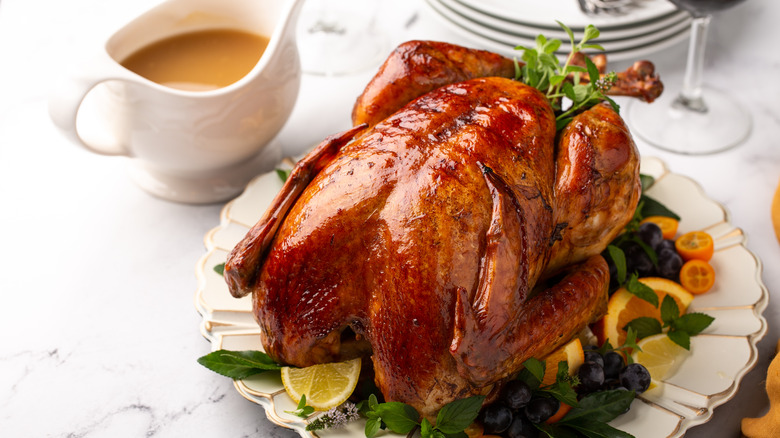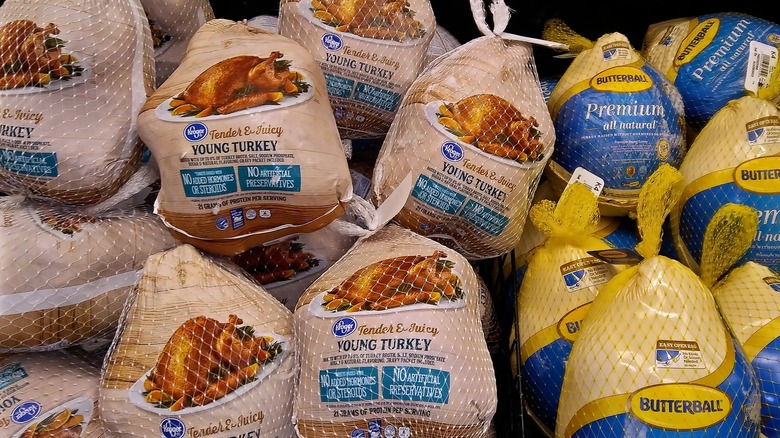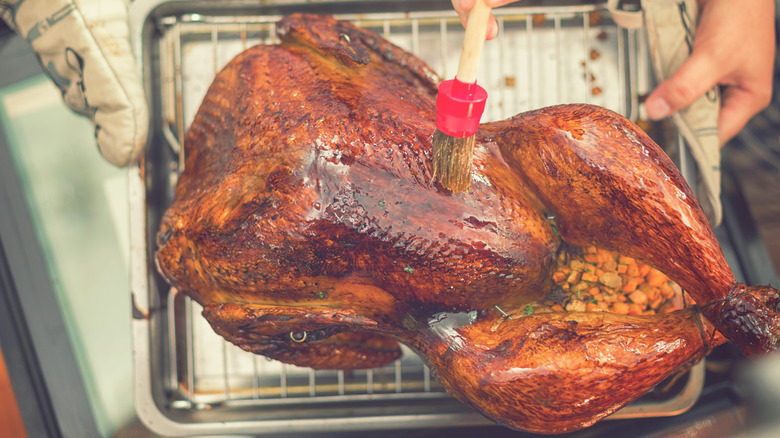The Store-Bought Turkey Label You Should Avoid
Buying a turkey at the store can be an intimidating feat on its own, not to mention learning how to properly thaw a turkey, along with the daunting task of preparing the bird until tender and juicy without drying it out. When perusing the poultry case, you may see turkeys labeled "self-basted" or "basted" — a processing method employed by manufacturers to help make preparation easier by keeping the turkey extra moist as it roasts. However, if you see this label, you probably should avoid buying this type of bird since the meat may be moist, but the texture will be a bit wetter than desired and the flavor profile muted.
Self-basted turkeys are injected with a liquid and salt solution, sometimes containing additional fat, broth, and flavorings. These types of turkey will do the trick if you want to avoid dryness at all costs and keep your poultry preparation simple. However, the extra liquid and salt injected into the turkey often makes for roasted meat that's a bit mushy and lacking in flavor. So, if you're making a bird to impress a table of guests, you're better off taking the extra time, effort, and know-how to baste it yourself.
For best quality, look for turkeys without the self-basted label
To prepare a turkey yourself, it's best to go with a store-bought turkey without any additional water added — this way, you can better manage the flavor and moisture-retention techniques in the preparation and cooking process. Luckily, spotting a self-basted turkey at the store is relatively easy since the indication and any basting ingredients are required to be included on the packaging. You may see a self-basted turkey labeled as such or with other wording such as "water added” or "enhanced." Keep in mind that just because a turkey is labeled as natural doesn't mean it hasn't been injected with a basting solution — it's still wise to check for basting labeling or added ingredients like water, fat, or seasonings.
While self-based birds are usually the cheaper options on store shelves, the added liquid solution can be as much as 3% of the bird's volume prior to processing. Though the price tag may be more affordable at first glance, by choosing this option, you are basically paying for a slightly watered-down bird — and that will be reflected in the taste and texture. The good news is that if you go with a higher quality bird without water added, it's still very possible to keep the meat nice and moist during the roasting process.
How to baste your turkey at home
While you should avoid turkeys labeled self-basted if the best flavor and texture are your objectives, basting as a turkey-roasting technique is one that some cooks swear by (though others prefer a salty dry or wet brine to keep the bird moist). Basting a turkey is a fine balance of achieving a flavorful juiciness while retaining a crisp outer skin — something self-basted turkeys can't always achieve.
To baste a turkey in its own fatty juices as it cooks, periodically coat the exterior of the meat (especially the breasts and other larger, lean portions) with the juices using a large spoon, pastry brush, or turkey baster. This will ensure all cuts of the meat cook nice and evenly, without drying. Before cooking, you can also add softened butter combined with lemon zest and herbs under the skin to keep the meat moist and the skin crispy. Or try making your own basting liquid by melting butter with broth, citrus, and herbs like thyme or rosemary.
When basting a turkey, don't overdo it. Just baste the turkey about every 40 to 45 minutes to avoid opening the oven too much (which releases heat and could cause the turkey to cook slower than intended). Pay close attention to cooking times and temperatures, testing your turkey with a meat thermometer before removing it from the oven — according to the U.S. Department of Agriculture it should read 165 degrees Fahrenheit for food safety and optimal doneness.


